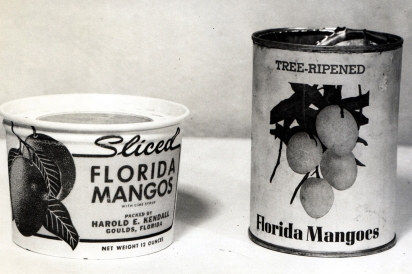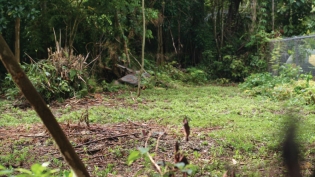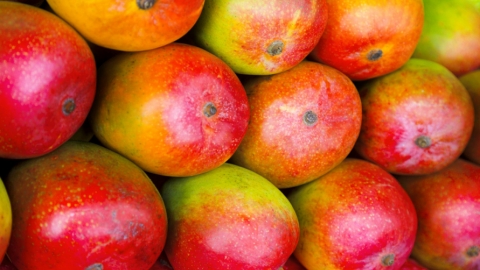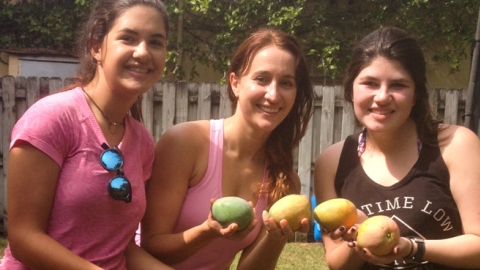Rooted in Passion
Editor’s note: Richard Campbell’s son Thiago wrote this guest column. He is heading to the University of Florida in August to pursue an undergraduate degree in Horticultural Sciences. “I hope to one day become a horticulturist like my father, although I’m not sure yet which specification of horticulture I would like to pursue,” he says.
The soil slid out of my hand and fell onto the seemingly insignificant object, covering it like a blanket over a newborn, promising new life and hopefully a healthy future.
I knew from the first time that I had planted this seed that I had fallen in love. Horticulture was my true calling, and I felt as if my body and soul were one. The feeling of successfully nurturing and raising a plant to maturity fulfills me, and I know that for me it will always be that way.
The mango called to me as a child. My father is a leading mango horticulturist, so this was good. From the beginning I helped my father plant trees in the yard, picked fruit, and sometimes pruned trees in preparation for a hurricane. I loved horticulture. My father was my mentor, and he taught me all I know about horticulture. But now I strive to take it further.
Garden Work
We planted vegetables in the fall, and grew and maintained them healthy through winter and spring. During summer, I took over the garden. Summer was the worst time to plant things because of the amount of pests and disease, but I used that opportunity to practice my horticultural skills. I planted everything that could grow here, ranging from sweet corn to radishes. The sweet corn tended to die because of pests, and that helped me learn what I did wrong and what I could do differently in order for the corn and other plants to survive.
Of course, the most I learned was when I would go help my father with the mangos, considering that was his highest level of expertise. I would ask him about everything I saw so I could better understand it. Although I got on his nerves sometimes by asking so many questions, I could tell he loved the fact that I was so interested.
Family Project
The game changed when we initiated the BA Campbell Estate orchard on the adjacent property that belonged to my grandparents. This project is a true family affair, consisting of a quarter-acre of the world’s best mangos, grown to the highest standard of horticulture and providing a lifetime of sustainability, income and learning. These are no ordinary mango fare; the cultivars in our orchard are dwarf, productive, disease tolerant and – above all – tasty. ‘Angie’, ‘Rosigold’, ‘Fairchild’, ‘Ruby’, ‘Ceci Love’, ‘Orange Sherbet’, ‘Coconut Cream’, to name a few, are now beginning to bend their branches laden with fruit. Thus begins the harvest and the learning.
Being able to use plants to change the world and make it a better place has fueled my desire in horticulture and taught me to appreciate the necessity of plants for our survival, whether for the oxygen they produce or the minerals they contain. My father often speaks about the art of horticulture and what can be lost in the blind application of horticultural science. Perhaps I don’t fully appreciate this distinction, but the BA Campbell estate provides my brothers and me the opportunity to learn with our own sweat about the art of horticulture, while we earn money for our education.
The First Mangos in Paradise
It began around 1880 with the fateful encounter between the ‘Turpentine’ and ‘Mulgoba’ mangos. This unlikely pair – the pedestrian, fibrous, yet spicy ‘Turpentine’ from the Caribbean lowlands, and the well-bred, refined, smooth-fleshed ‘Mulgoba’ of India – joined together under the swaying coconuts of West Palm Beach. This chance encounter went unheralded for more than a decade, until in 1910, on the shores of Biscayne Bay, the progeny of this union was revealed to the world.
The ‘Haden’ mango, born of a ‘Mulgoba’ seed entrusted to Mrs. Florence Haden of Coconut Grove, embodied the best traits of both parents. With an eye-stopping display of reds, yellows and greens overlaid by a sea of white highlights and an excellent flavor, the ‘Haden’ thrived in her homeland, quickly dominating the mango industry of Florida. ‘Haden’ also proved to be a good parent, giving rise to the most important export mango cultivars in the world – the same cultivars that would erase her own dominance in Florida. From the seeds of ‘Haden’ came the delicate and sweet flavored ‘Kent’ of Miami; the mammoth pastel hues of ‘Keitt’ from Homestead, and the gorgeous, firm and productive ‘Tommy Atkins’ of Fort Lauderdale. As to the identity of the fathers, there exists only conjecture. Due to their good looks, productivity and facility at long-distance travel, they were soon to become the most important export mangos in the Western Hemisphere.
The next time you buy a mango along the roadside or at your local grocery store, reflect upon that fateful evening over a century ago, when the ‘Turpentine’ and ‘Mulgoba’, two mangos with little in common, united to give rise to the ‘Haden’, who along with her progeny, came to shape the world of mangos as we now know it.
– Richard Campbell













